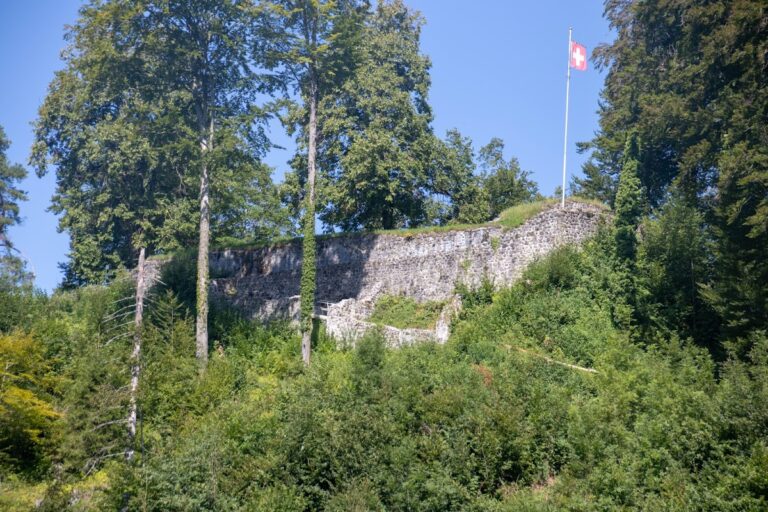Iberg Castle: A Medieval Fortress in Wattwil, Switzerland
Visitor Information
Google Rating: 4.5
Popularity: Low
Google Maps: View on Google Maps
Official Website: www.wattwil.ch
Country: Switzerland
Civilization: Medieval European
Remains: Military
History
Iberg castle ruins sit on a hill in the municipality of Wattwil, Switzerland. The fortress was built in the early 13th century by the ministeriales—unfree knights—serving the Abbey of St. Gallen, an influential religious institution. Its main purpose was to oversee and manage the abbey’s lands in the surrounding area, including the villages of Wattwil and Kappel.
The castle’s name is believed to have originated from “Eibenberg,” a local place name that was adopted by the first recorded ministeriales living there, who appeared in documents as “de Iberch” in 1240. Soon after its construction around 1230, the lords of Iberg expanded their influence through acquiring fiefs and clearing land, solidifying their local presence under the abbey’s authority.
In 1249, the castle became the site of a conflict when Count Kraft I of Toggenburg seized it during a dispute with the abbey. For a time, he renamed the fortress “Kraftsberg,” but it was returned to the abbey’s control six years later. The castle’s strategic importance continued into the late 13th century when, in 1290, Konrad von Gundelfingen, a rival abbot backed by King Rudolf of Habsburg, besieged and captured it. Following a settlement in 1292, the castle was restored to the abbey’s possession.
The early 15th century brought renewed violence during the Appenzell Wars. In 1405, forces from the Appenzell region attacked and destroyed Iberg castle. After the conflict, Prince-Abbot Kuno von Stoffeln oversaw its reconstruction beginning in 1408, adapting it into a residence for the abbey’s officials known as vogts. Following the death of the last Toggenburg count in 1468, the abbey fully integrated the surrounding territory, and the castle occasionally served as the home of the St. Gallen bailiff.
During the turbulent years of the Thirty Years’ War (1618–1648), the abbey safeguarded its precious church valuables by storing them within the castle’s cellars. Later, in the early 18th century, the fortress was briefly occupied in 1710 by rebellious subjects from Toggenburg. However, after the Peace of Baden in 1718 ended regional unrest, the castle returned to abbey control. Soon afterward, the decision was made to slight the fortress—intentionally damaging it to prevent future military use.
With the abbey’s dissolution in the early 19th century, Iberg entered private hands in 1805. The last residents left in 1835, when Jakob Schwander, protesting local social policies, dismantled parts of the castle, removing roofs and masonry and accelerating its decay. Eventually, the municipality of Wattwil acquired the site in 1883 and initiated restoration efforts in the early 20th century, ensuring its partial preservation.
Remains
Iberg castle is a medieval hilltop stronghold built atop a 740-meter-high hill southwest of Wattwil, strategically positioned to overlook the Thur valley. The fortress was enclosed by an irregularly shaped polygonal ring wall, combining natural and man-made defenses. On three sides, a broad ring moat and earth ramparts strengthened its protection, while a steep ravine to the south provided a natural barrier.
At the heart of the complex stands the bergfried—a tall, strong tower measuring roughly 9 by 8.7 meters at the base, rising five stories high. The bergfried’s walls are notably thick, between 1.8 and 2.2 meters, built of local stone, offering both a vantage point and defense. Originally, access to the bergfried was through an elevated doorway on the southeast side, about five meters above the courtyard floor, making entrance difficult during attacks. Today, a reconstructed staircase allows access at ground level.
The castle once contained a palas, the main residential building where the lord and his family lived, as well as various economic structures supporting daily operations. Although the exact remains of these buildings are not detailed, their existence is documented. Over time, parts of the ring wall, the bergfried’s upper floors, and the gatehouse have been restored and stabilized to preserve the site’s integrity. The gatehouse marks the main entrance and would have controlled access to the fortress.
Excavations and historical records confirm that these features embody the castle’s complex role as a defensive structure and administrative center throughout the Middle Ages. Their preservation allows insights into medieval fortification methods and the shifting political and military history embodied at Iberg.







